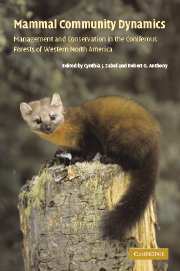 Mammal Community Dynamics
Mammal Community Dynamics Book contents
- Frontmatter
- Contents
- List of contributors
- Foreword
- Acknowledgments
- Part I Management and conservation issues for various taxa
- Part II Community and ecosystem relations
- 10 Relationships among fungi and small mammals in forested ecosystems
- 11 Ecology of coarse woody debris and its role as habitat for mammals
- 12 The ecological role of tree-dwelling mammals in western coniferous forests
- 13 The role of ungulates and large predators on plant communities and ecosystem processes in western national parks
- 14 The role of the lynx–hare cycle in boreal forest community dynamics
- 15 Associations of mammals with riparian ecosystems in Pacific Northwest forests
- Part III Conservation issues and strategies
- Index
- References
13 - The role of ungulates and large predators on plant communities and ecosystem processes in western national parks
Published online by Cambridge University Press: 15 December 2009
- Frontmatter
- Contents
- List of contributors
- Foreword
- Acknowledgments
- Part I Management and conservation issues for various taxa
- Part II Community and ecosystem relations
- 10 Relationships among fungi and small mammals in forested ecosystems
- 11 Ecology of coarse woody debris and its role as habitat for mammals
- 12 The ecological role of tree-dwelling mammals in western coniferous forests
- 13 The role of ungulates and large predators on plant communities and ecosystem processes in western national parks
- 14 The role of the lynx–hare cycle in boreal forest community dynamics
- 15 Associations of mammals with riparian ecosystems in Pacific Northwest forests
- Part III Conservation issues and strategies
- Index
- References
Summary
Introduction
Human activities have caused fundamental changes in relationships between predators and large herbivores in ecosystems of western North America. In particular, large predators, especially wolves (Canis lupus) and grizzly bears (Ursus arctos), have been eliminated from most of the region. Human developments, as well as agricultural and livestock grazing activities have altered or eliminated many migration routes and habitats of ungulates. Developments such as towns and paved areas have eliminated habitat. Alternatively, human modifications to the landscape, in some cases, have created new and more fertile habitats for ungulates. Habituated ungulates use lawns, golf courses, and agriculture fields that are rich in nutrients in many of the Rocky Mountain states and provinces (Thompson and Henderson 1998).
No magic formula exists for setting goals for the appropriate number of ungulates in a national park or in a more managed ecosystem. National Park Service policy calls for managing for natural processes within the parks, where high ungulate populations may be managed if the concentrations are due to human effects (National Park Service 2001; NPS-77). Unfortunately, most current-day park ecosystems are extensively altered by many human factors, such as the extirpation of large predators, abbreviated or lost migrations of ungulates, and concentrations of ungulates on artificially rich human habitats, such as restored agriculture sites (in many eastern and mid-western parks) or lawns and golf courses within or adjacent to the parks. Determining what constituted natural conditions and natural processes under these altered states can be difficult.
- Type
- Chapter
- Information
- Mammal Community DynamicsManagement and Conservation in the Coniferous Forests of Western North America, pp. 444 - 486Publisher: Cambridge University PressPrint publication year: 2003
References
- 7
- Cited by


